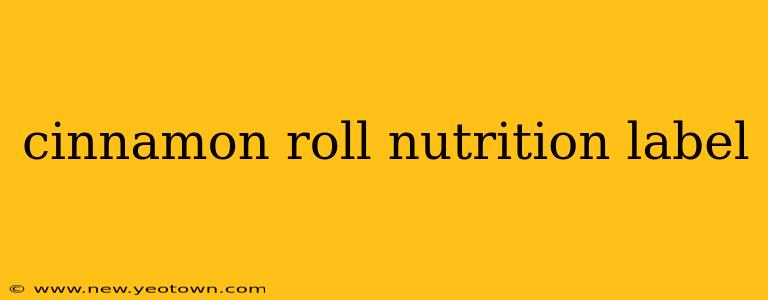Decoding the Cinnamon Roll Nutrition Label: A Sweet Story with a Healthy Twist
Ah, the cinnamon roll. That warm, gooey, cinnamon-spiced delight that can transport you straight to a cozy bakery on a chilly morning. But before you indulge in that sugary spiral of happiness, let's take a closer look at what's actually in that delicious treat – and what that means for your health. Understanding the nutrition label is key to making informed choices, even when faced with tempting baked goods.
Let's embark on a journey through a typical cinnamon roll nutrition label, unraveling the mysteries behind those numbers and exploring how to make smarter snacking decisions.
What are the main components of a cinnamon roll's nutritional profile?
A typical cinnamon roll nutrition label will prominently feature these key players:
-
Calories: These are the units of energy your body gets from consuming the roll. Expect a significant calorie count, often exceeding 300-400 per roll, due to the high sugar and fat content.
-
Fat: Cinnamon rolls contain both saturated and unsaturated fats. Saturated fats, found in butter and dairy products commonly used in the dough and frosting, should be consumed in moderation. Unsaturated fats, while healthier, are still calorie-dense.
-
Carbohydrates: This is where a large portion of the cinnamon roll's calories come from. The carbohydrates consist primarily of refined sugars and simple starches from the flour and added sugars.
-
Sugar: This is usually a high number. The sugar content includes the naturally occurring sugars in the flour and the generously added sugar in the frosting and dough itself. High sugar intake can contribute to weight gain and other health issues.
-
Protein: This will likely be a relatively low number. Cinnamon rolls are primarily a source of carbohydrates and fats, not protein.
-
Fiber: The fiber content is usually low, depending on the type of flour used. Whole wheat flour would increase fiber content slightly, but most cinnamon rolls use refined white flour.
How many calories are in a typical cinnamon roll?
This highly depends on the size and recipe of the cinnamon roll. A standard-sized cinnamon roll from a bakery or coffee shop could easily contain anywhere from 300 to 500 calories, sometimes even more! The calorie count is largely influenced by the amount of frosting, butter, and sugar used.
What are the key ingredients to watch out for?
Besides the obvious sugar, pay attention to the following:
- Refined flour: This offers little nutritional value compared to whole-grain alternatives.
- Trans fats: While hopefully absent in most modern cinnamon rolls, these are unhealthy fats that should be avoided whenever possible.
- High fructose corn syrup: This is a type of sugar that’s been linked to various health problems.
Are there healthier versions of cinnamon rolls?
Yes! While it's difficult to make a truly "healthy" cinnamon roll, some bakeries and home cooks offer healthier alternatives:
- Whole wheat flour: Using whole wheat flour instead of refined white flour increases the fiber content and nutritional value.
- Reduced sugar: Some recipes aim to decrease the sugar content, making them less sweet but healthier.
- Smaller portions: Enjoying a smaller cinnamon roll or sharing one with a friend significantly reduces calorie and sugar intake.
How can I make informed choices when buying or eating cinnamon rolls?
- Read the nutrition label carefully: Pay close attention to the serving size, calories, sugars, and fats.
- Compare different brands: Look for options with lower sugar and fat content.
- Choose smaller portions: Satisfy your craving without overindulging.
- Enjoy occasionally: Treat cinnamon rolls as an occasional indulgence, not a regular part of your diet.
The journey to enjoying your favorite treats responsibly starts with understanding the ingredients and nutritional information. By making informed decisions, you can still savor the deliciousness of a cinnamon roll without compromising your health. Remember, moderation is key!

